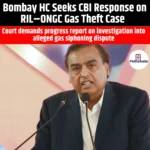Rahul Gandhi Flags Voter Fraud Concerns
|
General Studies Paper II: Judiciary, Election Commission of India |
Why in News Rahul Gandhi Flags Voter Fraud Concerns?
Recently Rahul Gandhi raised concerns about possible voter fraud during a dinner meeting of the INDIA Bloc in August 2025. His remarks came as political discussions within the alliance focused on fair voting practices and strengthening public trust in democracy.
- His remarks were backed by data, photographs, and specific case studies from states like Karnataka and Maharashtra.
Rahul Gandhi’s Key Concerns on Voter Fraud
- Allegations of “Vote Theft”: Rahul Gandhi used the term “vote theft” to describe what he said happened in Karnataka during previous elections. He said that the Election Commission worked in cooperation with the ruling party to manipulate the voter lists. According to him, the same methods were also seen in Maharashtra.
-
-
- Rahul Gandhi shared figures indicating that around 4 million new voter names were added in Maharashtra within just five months. He claimed that machine-readable voter lists were not provided to political parties, which made it difficult to verify authenticity.
- Rahul Gandhi highlighted the case of Bengaluru Central Constituency in Karnataka. Based on his analysis, Congress should have won 16 Lok Sabha seats in the state, but the results showed only nine victories in 2024. Rahul Gandhi claimed that out of 650,000 registered votes in the area, around 100,000 were fraudulent.
-
- Duplicate Voter Entries: According to Rahul Gandhi, more than 11,900 voters were registered in more than one location. Some individuals appeared in voter lists in both Karnataka and other states like Uttar Pradesh. These duplicates, he argued, could lead to multiple votes by the same person.
- Invalid Addresses: The presentation also highlighted around 40,000 voters whose addresses were either incomplete, false, or marked with zeros. Rahul Gandhi said that in some cases, these addresses did not exist in reality. This showed a failure in verification procedures and opened the door for misuse.
- Bulk Voters at a Single Address: Rahul Gandhi pointed to more than 10,000 voters registered at just a handful of addresses. In some cases, 50 to 60 voters were listed at the same residence. He shared photographs of houses and small buildings where dozens of registered voters supposedly lived. This was not physically possible and indicated deliberate manipulation.
- Issues with Voter Photographs: Another irregularity involved missing or invalid photographs in the voter list. Rahul Gandhi claimed that over 4,100 voters either had no photo or had a photo so small and unclear that it was impossible to verify identity. Without a proper image it was easy to impersonate a legitimate voter.
- Misuse of Form 6: Form 6 is meant for adding the names of new voters who have never been registered before. Rahul Gandhi alleged that this form was misused in thousands of cases. His team found examples of elderly voters who were already on the list being added again through Form 6, leading to multiple entries for the same person. He claimed that more than 30,000 voters had been added in this manner.
Also Read: Issue of Duplication in Voter Identification Number
Past Instances and Allegations of Voting Irregularities
- Booth Capturing: Booth capturing became a serious concern during the 1970s and 1980s, particularly in states like Bihar and Uttar Pradesh. Political workers would seize control of polling stations. They would prevent legitimate voters from entering and casting ballots. This practice undermined faith in elections and often led to violence.
- Voter List Manipulation: During the 1990s, several state elections saw allegations of voter roll manipulation. In some constituencies, political parties were accused of adding fake names or removing legitimate voters from the list. These irregularities were harder to detect at the time because voter lists were kept in paper form, making large-scale verification challenging.
- Electronic Voting Machine (EVM) Tampering: Electronic Voting Machines were used nationwide in the 2004 general election for the first time. While they reduced the chances of ballot stuffing, new allegations emerged. Some political parties claimed that EVMs could be tampered with to favor a specific candidate. The Election Commission maintained that the machines were secure and independent experts tested.
- Voter Deletions & Voter Roll Discrepancies: Opposition parties in states like Andhra Pradesh and Telangana alleged that millions of legitimate voters had been removed from the rolls. Many citizens reported that their names were missing on polling day despite having valid voter ID cards. Also, in the 2019 Maharashtra Assembly elections, opposition leaders claimed that millions of names were added or removed without proper verification.
Also Read: Electoral Reforms in India
Steps and Reforms Taken by the Election Commission of India
- Introduction of Electors Photo Identity Card (EPIC): In 1993, the ECI launched the Electors Photo Identity Card to prevent impersonation during voting. EPIC included the voter’s name, photograph, and personal details. Over time, the card became mandatory for identification at polling stations, significantly reducing duplicate and fake voting.
- Use of Electronic Voting Machines (EVMs): The ECI began experimenting with Electronic Voting Machines in 1982 in Kerala. After years of trials, EVMs replaced paper ballots in all constituencies by the 2004 general election. This reform eliminated invalid votes caused by improper marking and reduced the scope for ballot stuffing.
- Voter-Verified Paper Audit Trail (VVPAT): To increase voter confidence in EVMs, the ECI introduced the Voter-Verified Paper Audit Trail system in 2013. VVPAT allows voters to verify their selection through a printed slip that appears for a few seconds before falling into a sealed box. In the 2019 general election, VVPAT was used in all constituencies.
- Special Intensive Revision (SIR): The ECI regularly conducts Special Intensive Revision exercises to clean up voter lists. These involve door-to-door verification, public display of updated rolls, and inviting objections or corrections from citizens. This step ensures that duplicate entries are removed.
- Linking Voter ID with Aadhaar: In 2015, the ECI launched the National Electoral Roll Purification and Authentication Programme (NERPAP) to link voter IDs with Aadhaar numbers. The goal was to eliminate duplicate entries and improve the accuracy of rolls.
- Use of Technology: The launch of the National Voter Service Portal (NVSP) in 2015 marked a major step in digitizing voter services. Citizens can register as new voters, update details, and check electoral rolls online. The ECI also introduced a mobile application to make these services accessible on smartphones.
______________________________________
Related Articles
ECI To Implement Bihar Voter List Verification
ADR Report on Registered Unrecognised Political Parties in India
Chief Election Commissioner of India
_______________________________________









